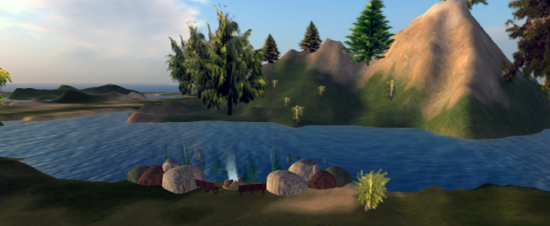SpotOn3D will hold a benchmark test on Wednesday, December 15 to determine the difference in performance of OpenSim version 0.7.1 and OpenSim 0.6.9 when they run in the cloud.

According to SpotOn3D co-founder and COO Tessa Kinney-Johnson, the test will be conducted from 2 to 3 p.m. SLT (Pacific time) on the SpotOn3D grid, and users interested in participating are encouraged to download the SpotOn3D client software and contact Kinney-Johnson at tessa@spoton3d.com for a test account.
“If you currently have an avatar on SpotON3D already there is no reason to get another, but you must be using an upgraded account to participate fully, as we’ll be conducting certain tests that will involve building and using scripts,” she said. “For those that don’t have an upgraded account we are providing  test accounts with full functionality. All they have to do is email me personally at tessa@spoton3d.com and we’ll get them their login info.”
She expects to have up to 100 avatars for this test, and 200 avatars for a follow-up test early next year after the grid finishes its upgrade to 0.7.1.
In addition to helping test cloud functionality, guests will also be treated to a performance by well-known virtual world musician Anek Fuchs, who’ll be testing a new audio delivery system on a Web page using Flash. He’ll be there between 2 p.m. and 4 p.m. SLT (Pacific time).
“We’ll have great music to keep everyone having fun and help test his technology at the same time,” said Kinney-Johnson. “We’re trying to see how many folks his system can take on.”
Cloud delivery
SpotOn3D offers OpenSim regions hosted on traditional, stand-alone server, but is also one of the few OpenSim hosting provider to offer cloud-based OpenSim hosting, using the Amazon EC2 cloud service.
Cloud-based hosting is inexpensive in the short term. For example, a company can easily load up 100 regions for a day-long event, and shut them down again once the event is over. Standard regions, however, are typically rented one month at a time.

At SpotOn3D, a cloud-based offering costs about $5 per hour, and can hold up to 100 simultaneous avatars. Concurrency is expected to double after the upgrade, to 200 simultaneous avatars.
OpenSim version 0.7.1 — currently used on OSGrid, GermanGrid, AlphaTowne and many of the largest grids — is a dramatic upgrade from the 0.6.9 version in other ways as well.
It includes the ability to put live Web pages on any surface — also known as the media-on-a-prim feature — includes a significantly more secure hypergrid protocol and reportedly is much more stable than previous versions of OpenSim.
SpotOn3D’s grids — which include the SpotOn3D main grid and Veesome — are not currently hypergrid-enabled, so SpotOn3D users won’t be able to benefit from that particular feature. however, the company does allow a single account and inventory to be accessed across multiple SpotOn3D grids.
Hypergrid teleports are currently not secure enough to protect SpotOn3D’s on-grid content creators. However, this may change in the future as the hypergrid technology improves.
Hypergrid 1.5, the protocol version supported by the latest release of OpenSim, protects inventories in that rogue grid owners, should they start to show up, will not be able to steal objects from visitors who come to their grid via hypergrid teleports. However, it does not enable grid owners to keep their content from leaving their grids by users who teleport elsewhere and intentionally give the content away or place it down on foreign regions. As a result, some commercial grids — including SpotOn3D and InWorldz — have hypergrid turned off in order to protect the content creators on their grids.
Hypergrid 2.0 is expected to solve the content protection problem, allowing content creators or grid owners to mark particular content as limited to just their grid, so that visitors are not allowed to take the content elsewhere.
Although hypergrid teleports preserve creator names and permissions on content, they also allow users to place content on regions that they own, and where they can make backups of entire regions, or of their inventories, and then distribute those backups in contravention of the permission system. In addition, if users place the content on their own grids, they can give themselves “God powers” and change the permission settings on objects.
For example, the Diva Distro is a free and popular way to set up a four-region mini-grid on any computer — or even a USB stick — that is, by default, hypergrid-enabled. In addition, many hosting providers, including ReactionGrid, SimHost, and Dreamland Metaverse, will host private mini-grids for their customers. Owners of these private grids can teleport out to other grids, get content, bring it back to their home grids and, if they are so inclined, change the permission settings on these objects or make backups.
Both SpotOn3D and InWorldz restrict the ability to make region or inventory backups, adding an additional layer of security for their on-grid content providers.
SpotOn3D and Veesome are owned and operated by Washington, D.C.-based Powersynch, LLC. The company is also in the process of launching three other grids, including the education-focused Edu-Merge, the business-focused Biz-Grid, and the event-oriented Musica Jam.
- Analysts predict drop in headset sales this year - March 25, 2025
- OSgrid enters immediate long-term maintenance - March 5, 2025
- OSgrid wiping its database on March 21: You have five weeks to save your stuff - February 15, 2025
